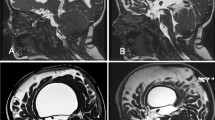Abstract
Methods
Simultaneous shunt placement and neural tube repair are described and compared with a concomitant series of patients with delayed shunting. Twenty-eight patients with a myelomeningocele underwent closure of neural tube defects at our Institution from 1998 to 2001. Eleven patients (Group 1) had concomitant surgery performed after birth. Group 2 (7 out of 28) included patients without hydrocephalus at birth, in Group 3 (4 out of 28) the children did not develop hydrocephalus, and Group 4 (6 out of 28) patients were born outside our hospital and referred for surgical care after birth.
Discussion
Simultaneous insertion of shunt and correction of a myelomeningocele do not pose an additional risk to the child and do have some advantages, facilitating healing of the back without CSF leakage and protecting the brain from the effects of progressive ventricular dilatation. Patients with a myelomeningocele born outside the hospital are prone to infectious complications.
Similar content being viewed by others
References
Aaslid R, Markwalder T, Nornes H (1982) Noninvasive transcranial Doppler ultrasound recording of flow velocity in basal cerebral arteries. J Neurosurg 57:769–774
Bowman RM, McLone DG, Grant JA, Tomita T, Ito JA (2001) Spina bifida outcome: a 25-year prospective. Pediatr Neurosurg 34:114–120
Caldarelli M, Di Rocco C, La Marca F (1996) Shunt complications in the first postoperative year in children with meningomyelocele. Childs Nerv Syst 12:748–754
Chadduck WM, Reding DL (1988) Experience with simultaneous ventriculo-peritoneal shunt placement and myelomeningocele repair. J Pediatr Surg 23:913–916
Dias M (2000) Myelomeningocele. In: Choux M, Di Rocco C, Hockley A, Walker M (eds) Pediatric neurosurgery. Churchill Livingstone, London, pp 34–59
Epstein N, Rosenthal E, Zito AD, Osipoff MJ (1985) Shunt placement and myelomeningocele repair: simultaneous vs sequential shunting. Review of 12 cases. Childs Nerv Syst 1:145–147
Hill A, Volpe JJ (1982) Decrease in pulsatile flow in the anterior cerebral arteries in infantile hydrocephalus. Pediatrics 69:4–7
Hubballah MY, Hoffman HJ (1987) Early repair of myelomeningocele and simultaneous insertion of ventriculoperitoneal shunt: technique and results. Neurosurgery 20:21–23
Kulkarni AV, Drake JM, Lamberti-Pasculli M (2001) Cerebrospinal fluid shunt infection: a prospective study of risk factors. J Neurosurg 94:195–201
Liptak GS, McDonald JV (1986) Ventriculoperitoneal shunts in children: factors affecting shunt survival. Pediatr Neurosci 12:289–293
Liptak GS, Masiulis BS, McDonald JV (1985) Ventricular shunt survival in children with neural tube defects. Acta Neurochir (Wien) 74:113–117
Liptak GS, Bolander HM, Langworthy K (2001) Screening for ventricular shunt function in children with hydrocephalus secondary to meningomyelocele. Pediatr Neurosurg 34:281–285
McLone DG (1998) Care of the neonate with a myelomeningocele. Neurosurg Clin North Am 9:111–120
Miller PD, Pollack IF, Pang D, Albright AL (1996) Comparison of simultaneous versus delayed ventriculoperitoneal shunt insertion in children undergoing myelomeningocele repair. J Child Neurol 11:370–372
Pang D (1995) Surgical complications of open spinal dysraphism. Neurosurg Clin North Am 6:243–257
Parent AD, McMillan T (1995) Contemporaneous shunting with repair of myelomeningocele. Pediatr Neurosurg 22:132–135
Piatt JH, Carlson CV (1993) A search for determinants of cerebrospinal fluid shunt survival: retrospective analysis of a 14-year institutional experience. Pediatr Neurosurg 19:233–242
Seibert JJ, McCowan TC, Chadduck WM, Adametz JR, Glasier CM, Wiliamson SL, Taylor BJ, Leithiser Jr RE, McConnell JR, Stansell CA, Rodgers AB, Corbit SL (1989) Duplex pulsed Doppler ultrasound versus intracranial pressure in the neonate: clinical and experimental studies. Radiology 171:155–159
Taylor GA (1992) Effect of scanning pressure on intracranial hemodynamics during transfontanellar duplex Doppler examinations. Radiology 185:763–766
Taylor GA, Madsen JR (1996) Neonatal hydrocephalus: hemodynamic response to fontanelle compression—correlation with intracranial pressure and need for shunt placement. Radiology 201:685–689
Author information
Authors and Affiliations
Corresponding author
Rights and permissions
About this article
Cite this article
Machado, H.R., Santos de Oliveira, R. Simultaneous repair of myelomeningocele and shunt insertion. Childs Nerv Syst 20, 107–109 (2004). https://doi.org/10.1007/s00381-003-0853-7
Received:
Revised:
Published:
Issue Date:
DOI: https://doi.org/10.1007/s00381-003-0853-7




